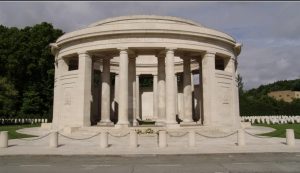Follow us on Facebook @FHofDW
Sergeant Stanley Herbert Cavell
Stanley was born on the 1st May 1887 in the village of Mongeham, near Deal, the eldest son of Herbert Thomas Vincent Cavell and his wife Sarah. Stanley’s father, Herbert, was the son of the Registrar of Births, Marriages and Deaths for Walmer and Deal, Thomas Vincent Cavell. He was educated at the National School in Walmer and in 1906 he decided to enlist in the Inniskilling 6th Dragoons. He may have been encouraged to do this by his brother Frederick, who was already established in the 3rd Dragoon Guards. The 6th Inniskilling Dragoons was a cavalry regiment first raised in 1689, being named the 6th regiment in 1751, which denoted its seniority in the Army List. This regiment had a long and much celebrated history, including the Battle of Waterloo, June 1815, commanded by the Duke of Wellington, and in the Anglo-Boar War (1899-1902).
In 1909, after three years’ service during which he served 360 days in Egypt, Stanley became disenchanted with the military life and decided to spend £25 to purchase his discharge. He returned home, where he re-joined his family in Walmer, helping in his father’s fishmonger and poultry shop on The Strand whilst living at home in Canada Road. Stanley resisted the call up at the commencement of WW1 but was to be signed up at Woolwich in April 1915 into the Army Veterinary Corps. In December of that year, Stanley married Louie Yearsley Ruck in the Parish Church of Bridge.
By the beginning of the 20th century, armoured cars and tanks were being manufactured, and this saw the end of the mounted soldier on the battlefield. Horses and mules were mostly required to be pack animals transporting heavy equipment and supplies across the muddy fields of France. The AVC provided a Mobile Veterinary Section as part of each Division that went overseas.
An estimated eight million horses, donkeys, and mules were sent overseas during WW1, with most of them never returning to the countries they were shipped from, which included the UK, America, and Australia.
The veterinary service was responsible for preventing the introduction and spread of contagious diseases, reducing wastage amongst animals by the prompt application of first aid. They relieved the field army of the care of sick and inefficient animals. They worked in established veterinary hospitals to which the many sick and injured animals were sent for care before being returned to a suitable unit in the field.
Members of the AVC were also responsible for the care of the many pigeons that were used to carry messages across enemy lines.
Stanley served in the Expeditionary Force in France. Even though being enlisted into the AVC meant that the soldiers were employed in the rear areas and relatively safe from fighting, Stanley was obviously caught up in the action and died of the wounds he received on the same day, 21st March 1918. His service to his country is commemorated on Panel 11 of the Ploegsteert Memorial, Belgium. He was 31 years old.
Not only did Stanley leave behind a grieving widow and son but also his parents, Herbert and Sarah. They were destined to be devastated a few weeks later with the news of the death of another son, John Leslie, aged 26 years, on 9th August in France. Killed in action.This Remembrance Day, we will remember those that gave the ultimate sacrifice for their country, the millions of grieving parents and the many millions of animals who served and sacrificed in war.
Dedicated to all the animals that served and died in War


